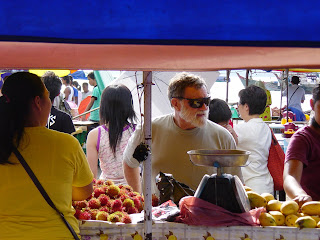Even agricultural scientists go on holidays, but like many scientists…….often a sort of bus man’s holiday. Currently in Malaysia, and this post covers a local fruit market in Kota Kinabalu, on the waterfront.
It is August, late wet season. At the market you can find mangoes – similar to the late season Nam Dok Mai in shape, size and flesh texture. Few green mangoes were on sale. The green types are consumed locally in Malaysia as a fruit – similar texture to apple, as well as going into chutney, or similar prepared foods. Plenty of limes too.
Jak fruit [chempadek] are common and the flesh very sweet. Rambutans are coming into the market, but many a little bit immature. Buy and eat in a day or so. Langsat [duku] and longans are very plentiful. Lychees were not seen at all! Plus the local papaya, watermelon – red, and both orange and green fleshed rockmelons. BUT……..also some durians, but not as common as in the Malay Peninsula market areas. As almost always – durians are banned in virtually every hotel. If you have smelt them you will know why – the smell is off and it permeates the air conditioning – EVERY WHERE! But they still taste good – you either like or hate the taste. Bananas are not in massive abundance, with a modest supply of local smaller sized fruit, somewhere between lady finger and Cavendish types. Quality of the bananas is very ordinary, tending to be overripe, with little opportunity to keep for more than a day before being too ripe for ordinary ‘peel and eat” use.
Local mangosteens are abundant, but small. Did not test drive the mangosteens, but looked ok. Also available in the market are the local palm fruits from the salak palm. Have not seen a lot, but are readily bought by local buyers.
Surprisingly, not many tourists are buying the fruit which is a bit unnerving, especially when you are the only European chit chatting with the stall holders and buying the produce. The fruit is fresh………..really tasty, too, and a great option to use for a snack or even lunch. The market is a bit on the nose – worse very late in the evening – but not so in the late afternoon when most of the action occurs. I do not think much worse than any I have been to elsewhere in Asia, and better than many. Some local colour is added with the inevitable odd rat or two seen.
Jak fruit [chempadek] are common and the flesh very sweet. Rambutans are coming into the market, but many a little bit immature. Buy and eat in a day or so. Langsat [duku] and longans are very plentiful. Lychees were not seen at all! Plus the local papaya, watermelon – red, and both orange and green fleshed rockmelons. BUT……..also some durians, but not as common as in the Malay Peninsula market areas. As almost always – durians are banned in virtually every hotel. If you have smelt them you will know why – the smell is off and it permeates the air conditioning – EVERY WHERE! But they still taste good – you either like or hate the taste. Bananas are not in massive abundance, with a modest supply of local smaller sized fruit, somewhere between lady finger and Cavendish types. Quality of the bananas is very ordinary, tending to be overripe, with little opportunity to keep for more than a day before being too ripe for ordinary ‘peel and eat” use.
Local mangosteens are abundant, but small. Did not test drive the mangosteens, but looked ok. Also available in the market are the local palm fruits from the salak palm. Have not seen a lot, but are readily bought by local buyers.
Surprisingly, not many tourists are buying the fruit which is a bit unnerving, especially when you are the only European chit chatting with the stall holders and buying the produce. The fruit is fresh………..really tasty, too, and a great option to use for a snack or even lunch. The market is a bit on the nose – worse very late in the evening – but not so in the late afternoon when most of the action occurs. I do not think much worse than any I have been to elsewhere in Asia, and better than many. Some local colour is added with the inevitable odd rat or two seen.

The local market operates daily, with most produce coming in around midday or even later, from areas outside of Kota Kinabalu, with the most active period later in the afternoon.
Good supplies of snake beans, plus bean sprouts, various Chinese green vegetables, okra, bitter gourd and kangkung are available. The kangkung is especially great to eat when chopped and quickly fried in a wok with garlic and chilli. Great stuff!! There are smaller volumes of European potatoes, sweet potato, carrot, and sweet corn. And of course – chillies………..in various shapes and sizes. Mostly small [ read HOT], although supplies of the larger less fiery types, were also readily available.
A lot of local ginger, turmeric, lemon grass is also available. Lemon grass is very thick at the base, indicative of a good quality. Much of the vegetables material comes from the east of Kota Kinabalu where the slopes rise to over 1000m and are well watered, although kangkung is grown at lower altitudes.
The area is vibrant, colorful and a great place to visit, with most stall holders keen to engage in a bit of banter, and many have a smattering of English vocabulary.


No comments:
Post a Comment